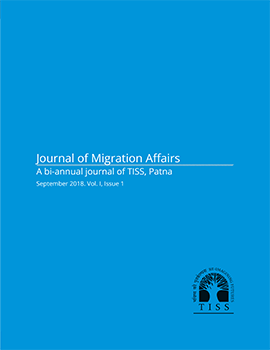©author(s)
Journal of Migration Affairs
Vol. II(2) : 1-2, March 2020
Pdf Issue: introduction.pdf
This special section on Gender and Migration for the Journal of Migration Affairs is important for various reasons. The ongoing pandemic and the nation-wide lockdown have brought on a sudden surge of attention on migration. The ‘migrant crisis’ that is slowly unfolding shows that migration, labour and capital are not in a simplistic relationship: they are in fact embedded in the particularities of gender, caste, class, region and other identities. The image of the migrant as a vague singular category does not necessarily provide a useful framework for understanding the crisis, and it is necessary to look at the particularities of the migrants’ identities. In the classic neo-liberal conceptualisation of migration, gender has always been an addendum to the economic activities undertaken mostly by men. Gender has been brought into migration studies as an afterthought through conventional migration research. However, feminist articulations of migration have changed this landscape of migration studies. In the current context of the ‘migrant crisis’, there is a requirement for amplifying the language of the feminist discourse, to emphasise how the extraordinary migration situation that we face today is not a product of extraordinary contexts but an outcome of ‘normativised’ gender-capital-labour relations.
This special section broadly brings in three aspects of gender and migration. First, it attempts to look at the question of identity, specifically focusing on the particularities of women’s labour within specific spatial-political contexts. The three papers in this section–one focusing on the cross-border migration of women from Bangladesh and Nepal, the other located in the East Godavari district of Andhra Pradesh and focusing on transnational migration to the Persian Gulf, and the third one on internal migrants in Marathwada and Western Maharashtra– bring in the specificity of their identity embedded in the particularities of the local political economy. Secondly, the papers bring into focus the labour market and attempt to show how labour markets get shaped by gendered labour and how that makes women’s work precarious. While doing so, all three papers resist the dominant approach to migration and labour that looks at precarious labour through the lens of the victim discourse. Engaging with feminist articulations of trafficking, these contributions emphasise the need to look at women engaged in precarious labour as significant political agents who are shaping the mobility paradigm.
The third focus of this section is on how they organise themselves, and also on mapping the trajectories of women’s labour in diverse contexts and analysing the multiple negotiations they make. Often these negotiations do not conform to the traditional idea of organising; instead, they represent significant political acts that emerge through forging new alliances and new forms of collectivising.
Ananya Chakraborty’s paper examines the lives of women migrants from Bangladesh and Nepal and attempts to understand their labour-market experiences. It also explores how their identity shapes these experiences: how Bangladeshi Muslim women often efface religious identities in order to survive in the labour market, and how their migration from Bangladesh is marred with notions of ‘illegality’. On the other hand, migrant women from Nepal reveal other kinds of vulnerabilities in the labour market, where stereotypes are often generated around their labour. The paper delves into the complex nature of gendered migration, whereby multiple identities intersect to shape the experiences of women. It also shows how the particularities of women in the labour market are, in turn, shaped by the various particularities of their gendered selves.
The paper co-authored by Pattadath, Chattopadhyaya, Arocha, and Gopal connects these gendered particularities in a significant way. Based on a pilot study conducted among women workers in Marathwada and Western Maharashtra, this paper unpacks multiple forms of precarity that get shaped by the local political economy. Their fieldwork among the women sugarcane cutters in Marathwada attempts to show that local patriarchal and heterosexual norms often shape the particularities of labour participation of women. In contrast to the condition of the women sugarcane cutters, the lives of sex workers in Western Maharashtra show stigmatised labour embedded in morality and patriarchy. In both contexts, the paper argues, forging alliances with diverse political articulations consolidates new forms of resistance to exploitation.
Going further into the question of identity, Asima Jena’s paper focuses on the transnational migration of Dalit women in the care economy from the Konaseema region in the East Godavari district. Jena questions the conventional migration approach which does not acknowledge women’s care work as significant economic work in the context of migration. The intersections of caste, labour and gender have been explored through the study of Dalit women’s emigration to the Persian Gulf as care workers. Looking at the specificity of women’s labour, Jena’s paper unearths how the state machinery subjects sexual subalterns to purificatory measures through the discourse of morality in order to maintain the socio- spatial-heterosexual-caste order.
The contributions in this section thus make a departure from the terrain of conventional migration scholarship to examine new forms of collectivising, while underscoring their precarity in the world of labour and migration.


Leave a Comment
Comments are moderated and will be published only if found appropriate. Comments may take some time to appear.
Your email address will not be published. Required fields are marked with *